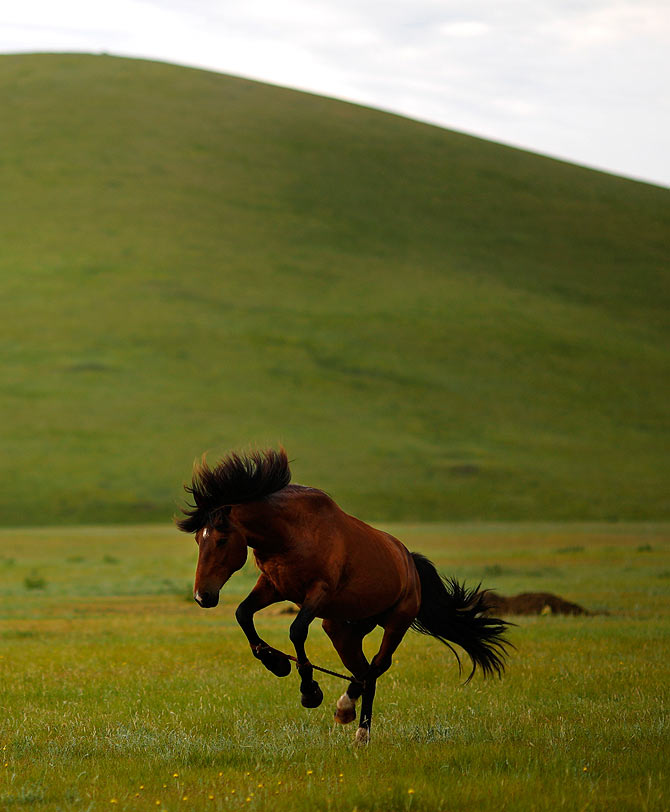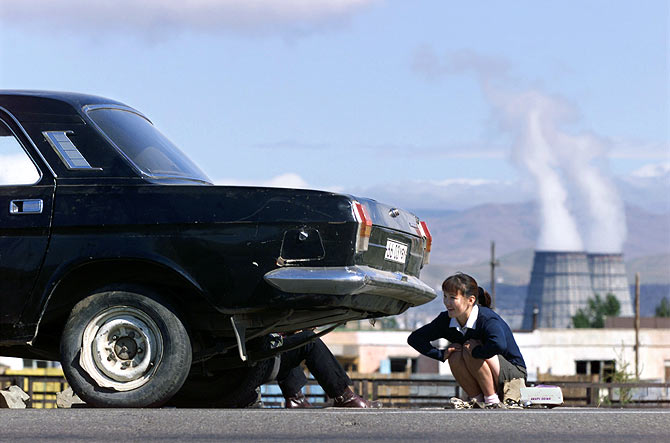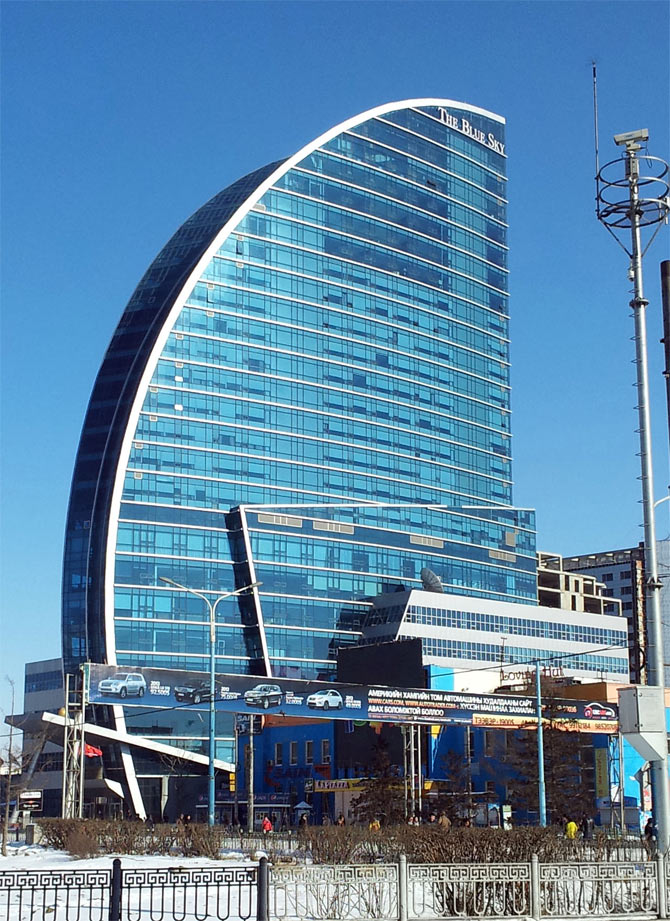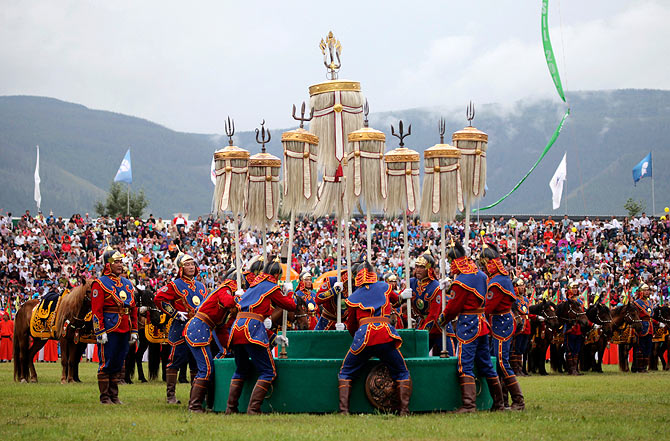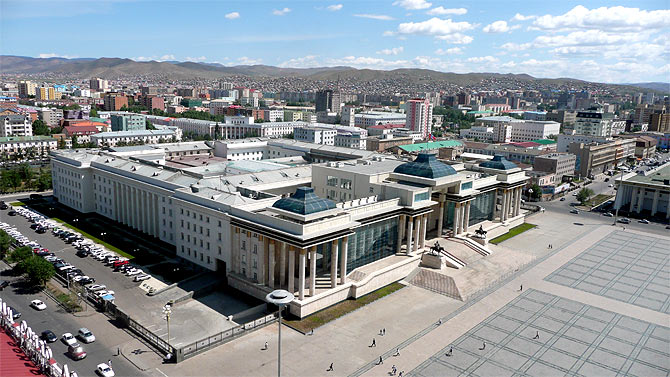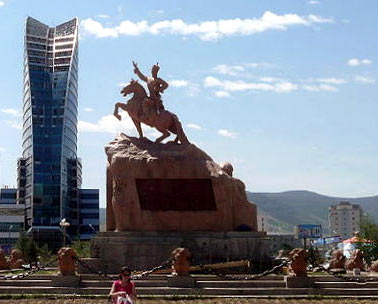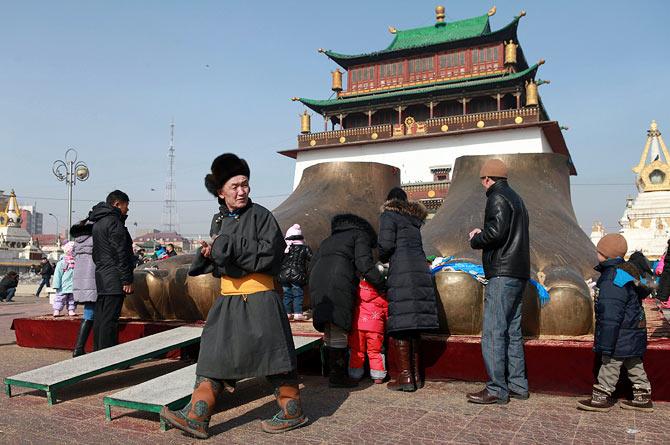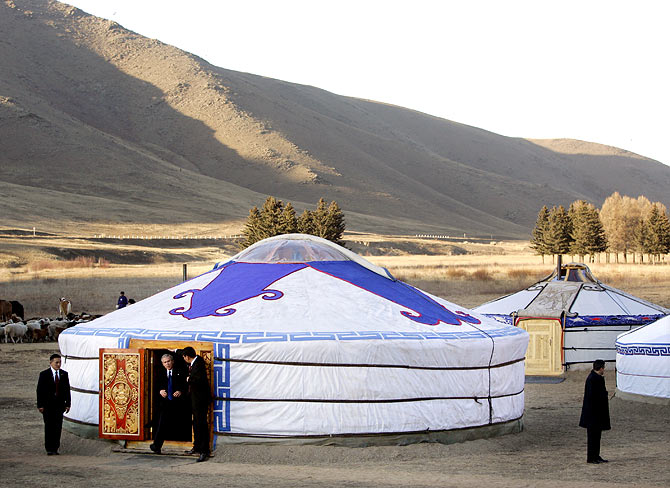 | « Back to article | Print this article |
PICS: The in-between world of Ulaanbaatar
A country lost in time? Or a country slowly stirring with ambition? Kushal Chowdhury wonders as he travels through the Mongolian capital.
The train rounds a hill and we catch our first glimpse of Ulaanbaatar from a slight vantage -- a sprawling cluster of low buildings, a great deal of it tin and asbestos and rust. What we see is unremarkable, neither particularly disappointing nor exhilarating.
The city lies there modestly and without pretension, like great many cities that lack unique character or iconic structures do.
Nevertheless, the sight lifts our spirits up considerably since, for many hours and miles all we have seen are panoramas of empty desert and steppes, jaw dropping for a long time until they have become something close to mundane.
By the time the train reaches the Ulaanbaatar railway station, it is past ten in the morning. The sun is already high up and it is warm and bright and will remain so for many hours.
It is July and summer, and the days never end.
It is not often that one spends a week exploring a foreign land without it being central to one’s itinerary. But that is how it is with Ulaanbaatar on this trip; our expectation from it, at best, is that of a side attraction in a larger, grander scheme -- the Trans-Manchurian rail trip from Beijing to Moscow.
There is something wonderfully liberating with travelling to places without preconceptions; the disappointments are muted and the joys, unexpected and intense.
Before the trip, I have, of course, spent time reading on the internet about the city of Ulaanbaatar and Mongolia in general, to learn of the country beyond the embarrassingly little that we already know -- the Gobi Desert and Genghis Khan.
Ulaanbaatar, I learn, has moved -- physically moved -- a number of times since it came to be in the 1600s.
For a long time, it remained a monastery on wheels and its accompanying ecosystem and moved to wherever the land was more fertile and the fauna abundant. The Ulaanbaatar of today, in its present location, was established in the late 1700s and remained there.
The impression I get, from reading, is of a city and country that have remained, until recently, cocooned in age old customs and traditions and a way of life that is still sparse and self contained.
Mongolia is half the size of India and still remains mostly uninhabited. Its entire population is a fraction that of Mumbai and Ulaanbaatar, its capital and largest city, accounts for one-third the entire country’s population, and yet, is about as populated as, say, Jabalpur, but only half as densely.
I read of life on the unending slopes, of living inside portable tent-like structures called ‘ger’ -- a nomadic existence, harsh and unforgiving and only occasionally romantic. I imagine men with hard weather-beaten faces on horses, tearing after their prey -- sometimes animals and sometimes other men. Men with double barrelled rifles and enormous knives and immovable moralities.
A country lost in time.
PICS: The in-between world of Ulaanbaatar
And yet, inevitably, in the past few years, I read of slowly stirring ambition. Of minerals and mining and exports and industry and forecasts of economic analysts. Of traffic congestion and pollution. Of social unrest and crime. Of a developing Ulaanbaatar skyline, tall glass buildings, sometimes casting shadows over and sometimes illuminating, ancient monasteries.
And so it is that when I reach Ulaanbaatar, I am still unsure what my expectations from it are. How much of it will still be austere old world charm and how much, fast cars and supermarkets?
We find a cab that agrees to take us to the hostel we have booked, near Sukhbaatar Square -- the centre of town. The cabbie quotes us a rate that sounds absurdly high until we calculate it in Indian rupees and decide there isn’t a point in quibbling.
One of the great joys of travelling to Mongolia is that the Indian Rupee buys nearly 30 Mongolian tögrög (pronounced as Tugrik) and one is able to experience a sense of wealth, bit like what the Europeans and Americans must feel when they travel the world.
From the cab, in fact even before we get into it, we observe amusing contradictions -- the signage on the railway station, in the shops and on advertising hoardings are a quirky mix of the Roman and Mongolian-Cyrillic alphabets -- ‘Restaurant’ written in the Roman and then below it, the restaurant’s name in Mongolian-Cyrillic. Advertising hoardings with English punch lines but unreadable product names.
The logic, names in the native script and the nature of the utility in English, is obvious and sensible for a city that is gearing up for international relevance.
There is no particular architectural style we can discern, the buildings are haphazard, multi-coloured and of wildly varying sizes.
For much of the way, we travel through what appears to be the main avenue of the city, and supermarkets and restaurants and fashion stores and tattoo parlours dot both sides of the street. The women are dressed in modern attire and have legs to die for.
The monasteries, wherever they are, are well hidden.
PICS: The in-between world of Ulaanbaatar
And then there are the vehicles and the streets.
The roads and signs are built for left hand drive, but most vehicles we see, including our cab, have the steering wheel to the right.
There are, of course, cars with the steering on the left as well, but throughout our time in Ulaanbaatar, we continue to see as many cars of one type as the other, and it is impossible to say on streets without dividers, which way one is expected to drive.
It also makes for heart-stopping experiences throughout; imagine yourself in a car with a steering wheel on the right side overtaking a car from the left on a street without a divider or on two-lane highway, with the oncoming traffic hurtling towards you. It is like overtaking from the wrong side in India with the added challenge of traffic from the other side coming straight at you.
When we have the chance, we ask some locals about this and they explain to us how, in recent times, with increasing affluence, a growing number of cars are imported from Japan, instead of China or Russia, and since Japan is unlikely to customise its vehicles for quantities as low as what Mongolia requires, the Japanese cars come as is, with the steering wheels on the right.
One of the stray bits of information I have come across from reading of the country is that injuries and casualties from collisions and road accidents in Ulaanbaatar have gone up substantially over the past decade.
PICS: The in-between world of Ulaanbaatar
Our hostel room, crammed with several two-storey beds, has a small balcony that opens out on to the street and offers a partial view of the Sukhbaatar square. There is room for two people on the balcony at a time -- the rest of it is occupied by clotheslines and empty beer bottles -- and early in the mornings and late in the evenings when the room is full, there are forever two people on it, smoking, while several others wait expectantly for them to finish.
During the day, however, when everybody is out in the city, one can lean on the parapet and watch the world go by, undisturbed.
In addition to the Sukhbaatar square, the balcony also offers an uninterrupted view of the Blue Sky Tower, one of Ulaanbaatar’s famous new high rises.
It does tower over Ulaanbaatar’s skyline at the moment, but in truth isn’t particularly high, and with its odd shape, resembles a shorter, better fed, Burj Al Arab.
The brilliant blue of a cloudless sky, uninterrupted by the presence of other tall buildings, reflects off its glass exterior, but I suspect, as the city grows and other intimidating structures grow around it, the tower’s resplendence will wear off in more ways than one.
PICS: The in-between world of Ulaanbaatar
By happy chance, we find out that our presence coincides with Mongolia’s national festival of Naadam -- a week of obscure sports competitions (wrestling, horse-racing and archery) and general revelry.
Competitors from across Mongolia turn up for the event. Most of the action takes place inside the National Sports Stadium, a large circular ground with spectator standing around it, very much like a cricket stadium.
We are not sure how tickets to the event are to be procured but a helpful lady at the hostel assures us that, once there, entry into the stadium will not be a problem.
We walk to the stadium, which is only a few kilometers away, and on the way, we see lines of makeshift stalls and bicycles on which meat is being barbequed and sold. We ask if it is horsemeat -- one of our primary motivations during the trip is to try as many varieties of meat as we find -- and are told that it is the meat from Mongolian wild asses.
It is thick and chewy and, with a smattering of salt, pepper and lemon, tastes delicious. Later in the evening, we will eventually also find horsemeat and ox tongue at a restaurant, and taste both, but by the end of it, the street side wild ass meat will remain my pick.
When we reach the stadium, like the good lady from the hostel foretold, a number of men crowd around us, asking if we’d like to buy tickets. They obviously quote rates well above those mentioned on the tickets and explain to us that the seats they have to sell have the best views, but we desist and locate the official ticket counter instead.
Tickets to the most expensive stands are indeed sold out, we are informed. We consult amongst ourselves and decide that we are unlikely to be able to make sense of the games and their rules anyway and the importance of a better view will likely be lost on us. We buy tickets to the cheapest available stand.
We reach after the Archery event is already completed and the wrestling competition is underway.
Several rounds occur simultaneously, all over the ground -- sets of two wrestlers, enormous but not too flabby, dressed in sumo-like attire and a fully clothed referee overseeing the action.
The objective, from what we can see, is to force the opponent down on the ground. The rounds last for very little time, less than a minute; how long can two similar sized people go at each other without one of them losing balance?
After a wrestler defeats his opponent, he does a ritual dance, a small lap around his fallen opponent, arms raised, with large lumbering steps in slow motion and ends it with a pat on the loser’s backside. It is a unique sight, grown men such as these prancing around like this and I wonder if some of them turn up in formal attire at the Blue Sky Tower on weekdays.
PICS: The in-between world of Ulaanbaatar
The Sukhbaatar square is a large open space, tiled and predominantly white, surrounded by busy streets on three sides and the Saaral Ordon (Government Palace) on the fourth.
Throughout the day, it remains crowded with tourists, the elderly and the noise of traffic. Right at the centre is a statue of a man on a horse, pointing at something in the distance.
On the side of the Saaral Ordon, under an archway with huge columns, is another statue, that of a portly man on a throne, staring benevolently at the world. Genghis Khan.
I recall a conversation with a friend, while we wandered around the Prince of Wales Museum in Mumbai, some months ago.
After we had walked past a line of statues and busts of important figures in our history, my friend remarked how, sculptors in our part of the world, almost always chose to sculpt their subjects, kings and Gods, in imperfect shapes, pot bellies, sagging cheeks and an overall lack of muscularity, an approach markedly different from their counterparts in Europe, where every sculpture looked like it had just stepped out of the gym.
We wondered why that is. With Kings, one could perhaps make a case for them preferring realistic reproductions to the Europeans’ preference for ideal bodies, but what about Gods?
PICS: The in-between world of Ulaanbaatar
The other statue, the man on a horse, we learn is of one Damdin Sukhbaatar, after whom the square is clearly named, although, at the time, we have no idea who he is. I assume that he must belong in the same era or thereabouts as Genghis Khan, during Mongolia’s glory days, but later learn that he was in fact at the forefront of Mongolia’s struggle for independence as recently as the early 1900s.
Wikipedia tells me he is considered the Father of Mongolia’s revolution, clearly their most important figure in the modern era, and yet, incredibly, I have never heard of him until then.
It must be so with innumerable figures in history, their statures immense and secure for all posterity in their own countries and yet completely ignored elsewhere. And there must be countless others, whose names even their own people no longer remember.
How does one know what will travel through history and how far? What will be important or relevant for generations hundreds of years later?
Art, I suppose, travels through time better than wars and conquests and revolutions and social change, for a work of art retains its form forever while society and the lay of the land remain in perennial flux.
Any notion that an empire once established, a country that becomes relevant for a time, will remain forever so, is laughable. And yet, in the shaping of human history, who is to say which is more important -- creating great art or leading a revolution?
PICS: The in-between world of Ulaanbaatar
I return to the Square again early the next morning, around seven, and find it silent and desolate. A few stray pigeons hop about and an old couple occupies one bench. There isn’t a vehicle on the street, not a single one.
The rays of the sun fall glorious and golden on the face of Sukhbaatar and his horse and on the buildings beyond, which the previous evening, had remained hidden behind their own garish neon signs.
I walk a block and then a little beyond it, until I reach the end of the city. It ends abruptly and without fuss; a street leads to the very end, buildings still on both sides, and then turns away, and beyond it lies the vast Mongolian landscape and nothingness.
A little later, after everybody else is up and we have had a dull breakfast in a fast food joint, we explore some of the city’s monasteries.
They are tucked away in various corners, away from the main thoroughfares, and still retain something of their air of isolation, peace and tranquility. It is a gorgeous day, the sky bluer than ever, and the stark colour tones of these monasteries stand proudly against this backdrop. The prayer wheels are bright and golden and we see our faces reflected on them.
At the square, on the way back to the hostel, we find much fanfare. There is a long procession of men and women in outrageous costumes and they dance and make merry and pose for pictures with tourists without asking for money. It is a ritual procession, we learn; an integral part of Naadam. It is quite a sight.
PICS: The in-between world of Ulaanbaatar
We have booked a ‘ger’ camp someway away from the city for the night; chosen from several such camps strewn at intervals from Ulaanbaatar for many miles, because it is the farthest we can find. It is on the banks of a river -- the Kherlan River I later find -- and, by late afternoon, we are on our way to it.
We leave the city behind in a matter of minutes and for the next hundred kilometers, apart from a few stalls that sell fermented horse milk (delicious) and men with enormous eagles on their arms which they rent out to anyone wanting a picture clicked with it, encounter no habitation.
The terrain remains uniformly green; in the distance we sometimes detect herds of sheep and wild ass. The highway is narrow but sufficient, since there is hardly any traffic on it. I suppose, if Mongolia succeeds in transforming itself into an industrious, prosperous nation, they will have to do something about the width of these highways in the future.
We take several breaks along the way, walk on the grass and have our pictures clicked from low angles -- reclining on the highway, with the road continuing on behind us and then disappearing over a hill.
The location of the camp and the scenery is everything we’d imagined and more. The waters of the river are a deep, wonderful blue and there are stretches of tall yellow grass on the banks. The green rolling steppes stretch out for as far as we can see in every direction.
I imagine characters in a Terrence Mallick film moving slowly and nonchalantly in this landscape, with outstretched arms and enigmatic expressions, to a Wagner and the sun’s flare on the camera lens.
It is a place for the recluse writer to spend months in and produce a masterpiece from. We have one day and busy ourselves with taking pictures.
The camp is spread over a large area and contains several ‘ger’ huts and is cordoned off by knee-high wooden fences, like ranches in Sergio Leone films. There is a shooting range even -- bows and arrows and a buffalo skin for a target. We try our hand at it for a while, fail miserably, and spend the remaining sunshine walking and rolling on the grass and staring into space. The sunset when it comes, is golden.
We stay awake through the night; inside the tent, a fire burns and we sit around it and drink rum. We step outside, every now and then, and take a look around the landscape, now moon-lit and ethereal, and sigh deeply before returning to the tent again.
By the time it is morning and we are done with breakfast and with the hopeless wondering about why we cannot stay back for a few more days, it is time to return to Ulaanbaatar.
We reach Ulaanbaatar with many hours of sunlight left. There are a few other places we have planned to see -- a museum here, another monastery there -- but when we get to the city, our heart is no longer in it. There is already an overwhelming sense of melancholy; we will leave the next day, we know, and never return.
And even if, someday, we do, who knows what Ulaanbaatar and Mongolia will have turned into.
